Gamification is gaining traction in the eCommerce industry as an effective way to captivate customer interest, boost sales, and enhance the overall user experience on your website. By implementing this strategy, businesses can foster an engaging environment where users have the opportunity to earn rewards, achievements, and bonuses for completing specific tasks. This integration of ecommerce gamification not only shakes up companies in online retail but also benefits both employees and clients alike. Let’s dive into how gamification shakes up companies in online retail, benefiting both employees and clients.
What is gamification?
Gamification in business is about adding a touch of gaming magic to a non-game setting (like your online store) to motivate and engage your team, customers, or users. The idea is to sprinkle gaming elements to hit business goals and encourage the behavior you’re aiming for.
Psychology behind gamification
Gamification leverages psychological concepts like motivation, social influence, and the desire for mastery to create a more interactive and enjoyable shopping environment. It exploits human tendencies such as the need for recognition, accomplishment, and status to increase customer engagement, loyalty, and ultimately, sales.
Benefits of Gamification for Business
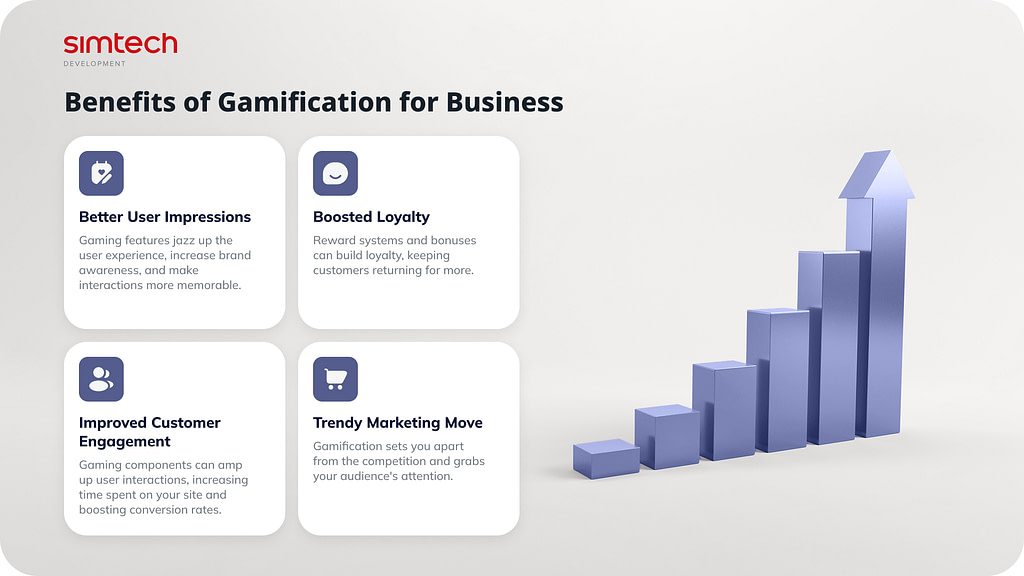
Businesses should consider gamifying their content for several reasons:
- Better User Impressions: Gaming features jazz up the user experience, increase brand awareness, and make interactions more memorable.
- Boosted Loyalty: Reward systems and bonuses can build loyalty, keeping customers returning for more.
- Improved Customer Engagement: Gaming components can amp up user interactions, increasing time spent on your site and boosting conversion rates.
- Trendy Marketing Move: Gamification sets you apart from the competition and grabs your audience’s attention.
So, what is the big plus of gamification for business? It creates a unique experience that keeps users coming back for more, boosting customer retention and driving desired actions.
Read more: Top Customer Retention Strategies For An ECommerce Website
How to use gamification in eCommerce?
Utilizing gamification elements effectively is the cornerstone of achieving success. Here’s the lowdown on gamification in business:
- Objectives and Goals: Set clear targets to give participants direction and motivation.
- Rewards and Recognition: Hand out rewards, badges, or shoutouts for a job well done to keep participants pushing for more wins.
- Progress and Development: Move participants up levels as they make progress, giving them that sense of growth and achievement.
- Competition and Teamwork: Stir up some friendly competition or teamwork challenges to keep things exciting.
- Feedback and Stats: Keep participants in the loop with feedback on their tasks and progress, helping them see what actions lead to success.
- Customization and Tailoring: Tailor game elements to suit particular needs and interests for more effective motivation, making gamification in ecommerce more personalized and engaging.
eCommerce Gamification Strategies and Popular Gamification Elements
Pros of gamification are undoubtable. But how to get the maximum of them? Consider adding the following:
- Bonus Programs and Loyalty: Give bonuses for orders, create loyalty programs with levels and achievements, let your audience swap points for discounts or goodies.
- Gaming Features on Your Site: Use digital badges, progress bars, or animations to track buyer achievements or loyalty program progress.
- Interactive Challenges and Games: Run contests, gaming tasks, or quests to keep customers engaged.
- Personalized Suggestions: Use game mechanics to dish out personalized product recommendations or tailored offers based on customer preferences.
- Achievement Unlocks: Introduce achievement or badge systems for specific actions like making a first order or writing a review to get users more involved.
Where can you apply gamification?
Gamification isn’t limited to one area – it’s popping up in marketing, employee training, project management, sales, client loyalty, healthcare, and beyond. Think loyalty programs with gaming twists, educational platforms with game mechanics, mobile apps with competitive features – the options are endless!
Best Gamification Examples
Imagine visiting an eCommerce website where your every interaction feels like a game. As you browse, you earn points for exploring products, writing reviews, and sharing content on social media. These points unlock virtual badges and achievements, showcasing your status as a loyal customer. You’re enticed to complete challenges and participate in contests to win exciting rewards, and a progress bar shows you how close you are to unlocking exclusive discounts. Perhaps you even get to spin a virtual wheel for a chance to win free products or special offers. The website gamification provides personalized recommendations tailored to your preferences, and you’re alerted to limited-time offers that create a sense of urgency and excitement. We gathered some cool instances of gamification ideas in action.
Duolinguo

Duolingo, a language education app, that spices up learning with levels, achievements, and daily learning rewards.
By earning points and leveling up, users unlock new content and challenges, propelling them further along their path to linguistic mastery. The concept of streaks adds an element of excitement, motivating users to return daily and maintain their practice routine to earn rewards and accolades. Furthermore, the competitive spirit is alive and well in Duolingo, as users can engage with friends and fellow learners on leaderboards to showcase their progress and achievements. By earning badges and unlocking special accomplishments, users can celebrate their successes and milestones along the way.
Starbucks

The loyalty program at Starbucks, where consumers earn stars for each purchase, unlocking perks as they collect more stars.
At the heart of the program lies the concept of Stars and Levels, where customers earn Stars for each purchase and progress through various Levels to unlock exclusive perks and benefits. This journey of accumulation and advancement transforms a simple coffee order into a rewarding quest for loyalty. The thrill of maintaining a streak is also present in Starbucks’ Loyalty Program, as customers are encouraged to visit regularly and earn Stars to fuel their streak and unlock additional rewards.
This element of consistency and dedication adds a layer of anticipation and satisfaction to each visit, turning a routine coffee stop into a rewarding habit. Customers navigate the program’s mechanics with finesse, strategically using their Stars to redeem rewards and unlock new levels of membership. The allure of reaching milestones and achieving status within the program drives customers to engage with Starbucks on a deeper level, forging a sense of connection and loyalty that goes beyond a simple cup of coffee.
Nike

Nike’s app that motivates users to exercise with challenges, achievements, and trophies.
Central to the Nike App experience are the concepts of Points and Levels, where users earn Points for completing workouts and progress through Levels to unlock exclusive rewards and challenges. This journey of achievement and advancement turns each workout session into a thrilling quest for personal growth and athletic excellence. The pulse-pounding excitement of maintaining a streak is also a core feature of the Nike App, motivating users to stay active and earn Points to fuel their streak and unlock additional incentives. This element of consistency and dedication infuses each workout with a sense of momentum and accomplishment, inspiring users to push their limits and strive for greatness.
Amazon
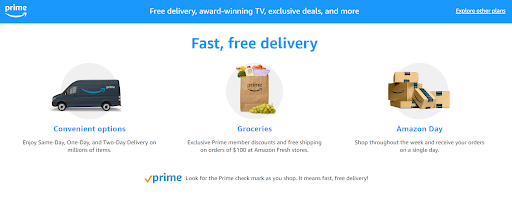
Amazon’s loyalty program offering free shipping and exclusive perks for members.
Customers navigate the program’s mechanics with finesse, strategically leveraging gamification for ecommerce by using their Points to access discounts, promotions, and other exclusive offers. The allure of reaching milestones and achieving status within the program drives customers to engage with Amazon on a deeper level, fostering a sense of connection and loyalty to the platform.
Burger King

One example of a brand that has successfully used gamified ads is Burger King.
Burger King has been known to incorporate interactive and engaging elements into their advertising campaigns to capture the attention of their audience and create a memorable brand experience. One notable campaign by Burger King that utilized gamified ads was the “Whopper Detour” promotion.
In this campaign, Burger King encouraged customers to download their mobile app and visit a McDonald’s location to unlock a special deal on a Whopper burger for just one cent. This gamified approach not only attracted attention but also drove foot traffic to Burger King locations and generated buzz on social media. By gamifying the ad experience and turning it into a playful challenge for customers, Burger King was able to create a unique and memorable interaction with their brand. This approach not only increased brand awareness but also encouraged customer engagement and participation, ultimately leading to a successful marketing campaign.
McDonald’s

One brand that has utilized a lottery-style approach in its marketing strategy is McDonald’s with its famous “McDonald’s Monopoly” promotion.
The McDonald’s Monopoly promotion is a well-known annual event where customers have the chance to win various prizes by collecting game pieces that correspond to properties on a Monopoly board. Customers receive game pieces with their food or drink purchases at McDonald’s, and these pieces can be used to collect property sets to win prizes ranging from free food items to larger rewards like cash, cars, or vacations. The game pieces often include instant-win prizes, as well as the opportunity to collect and complete property sets for bigger rewards.
Sephora
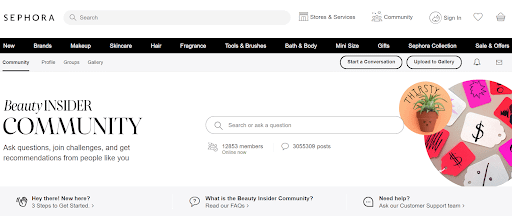
Sephora’s loyalty program with bonuses, gifts, and personified recommendations.
Customers navigate the gamified shopping features of the program strategically, using their Beauty Points to access rewards, exclusive products, and special beauty events. The sense of progression and accomplishment drives their engagement with the program, inspiring them to further explore the world of beauty and self-expression. As customers interact with the gamified elements of Sephora’s Loyalty Program, they unlock badges and achievements that celebrate their commitment and passion for beauty. These virtual tokens of recognition serve as a symbol of their expertise and dedication, adding a layer of pride and accomplishment to their beauty rituals.
Gamification in B2B eCommerce
Gamification spices up B2B eCommerce by adding game-like mechanics to business transactions, boosting engagement, nurturing relationships, and steering desired actions among corporate clients. You can apply games here in several ways:
- Training and Onboarding: Use gamified elements such as interactive tutorials, quizzes, and simulations to onboard new B2B customers and educate them about your products or services in an engaging manner.
- Incentive Programs: Develop incentive programs that reward B2B clients for reaching specific milestones, making repeat purchases, or engaging with your platform. This can include discounts, exclusive offers, or access to premium services.
- Data Visualization: Use gamified data visualization tools to help B2B clients analyze complex data sets, track performance metrics, and make informed decisions. Interactive dashboards and visual representations can make data analysis more engaging and actionable.
- Customized Solutions: Implement gamified configurators or product customization tools that allow B2B customers to personalize their orders, select options, and see real-time changes. This interactive experience can enhance customer satisfaction and increase sales.
By sprinkling gamification tricks into B2B eCommerce setups, businesses can rev up customer connections, foster teamwork, jazz up user experiences, and turbocharge loyalty and sales in the business-to-business world.
Examples of Gamification in B2B eCommerce platforms
In the wild world of the B2B industry, some savvy platforms have dialed up the fun factor with gamification to keep users hooked and spark the right actions. Here are a few examples where gamification tools could be the secret sauce in B2B eCommerce:
Salesforce
Salesforce’s Trailhead platform offers interactive learning modules and challenges for users to earn badges and points as they master Salesforce products and features. This gamified approach helps users stay engaged and motivated to continue learning.
IBM
IBM’s Watson Commerce Insights uses gamification to encourage sales teams to meet targets and drive revenue growth. Sales reps can earn rewards and recognition for achieving sales goals, fostering healthy competition and motivation within the team.
SAP
SAP’s Cloud for Customer platform incorporates gamified features like leaderboards and challenges to incentivize sales reps to engage with customers, close deals, and drive revenue. This gamified approach helps drive sales performance and improve customer satisfaction.
HubSpot
Hubspot’s Marketing Hub includes gamification features like goal tracking, progress bars, and rewards to motivate marketers to achieve their marketing objectives and drive lead generation. This gamified approach helps marketers stay focused and motivated to reach their goals.
Case #1: Gamifying eCommerce website through interactive elements and auction
The “Hong-Kong My Favorite” (HKMF) project is a Korean multi vendor eCommerce platform that managed to enhance user engagement by introducing gamification on the site. The implementation of the gamification idea included the following key elements.
- Auction Feature: We developed an auction function that allows buyers to bid on products with an interactive timer. The administrator could set auction parameters such as the minimum price for winning the product, starting price, and auction end time. These innovations helped improve the user experience on the HKMF platform and increase its attractiveness to buyers.
- Treasure Hunt: We added a game called “Treasure Hunt” to the site, where users could search for images of animals to win gift certificates. This increased traffic on the site and boosted user engagement.
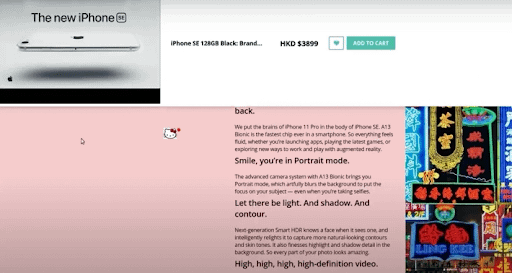
“That’s the best part! Exploring new features and customizing features and games like treasure hunt, that was very fun!” SANJI, CEO OF HKMF
Read more: Success Story: Multi-product marketplace with gamification and auction features
Case #2: Gamifying marketplace to simplify interaction with platform
Our client Urbankissed uses clickable images in the Shop the Look section to make it easy for customers to go from product recommendation to selection in no time! This gamified element allows customers to envision how different pieces can be styled together and encourages them to discover new products that complement their personal style.
Another gamification element on Urbankissed.co.uk is the use of virtual tokens or rewards for various actions taken on the website, such as signing up for the newsletter, sharing products on social media, or leaving reviews. These tokens can be accumulated and redeemed for discounts, exclusive offers, or special perks, creating a sense of achievement and incentivizing customers to interact more with the platform.

Read more: Success Story: Handmade Products & Unique Finds From Curated Small Brands
Case #3: Gamifying the marketplace to attract vendors
Gamification can be an effective tool for attracting vendors and partners. Through gamification on the site, vendors can progress through pricing plans. For example, they can earn points or coins for completing specific tasks, participating in contests, or achieving certain sales. In our practice, there was a request where gamification was used to attract vendors to a project selling second-hand items. Three types of sellers were highlighted on the site: one-time sale participants, fundraisers for online events, and regular sellers. To simplify the onboarding process for new merchants, we’ve added a new section in the admin panel designed to educate potential merchants about the features they get with each plan. Thus, vendors are engaged in a “game” where more attractive conditions become the stimulus for advancement. For the administrator, this escalation in the vendor pricing grid means higher revenue.
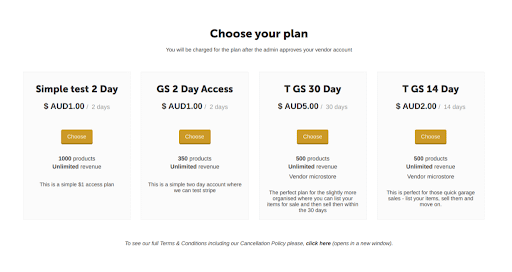
Case #4: Gamification for employees motivation

A merchandise store can be an excellent example of gamification, as it offers a unique shopping experience, engaging customers through gaming elements and mechanics.
Simtech Development has developed an internal merchandise online store, Simtech Market, at the request of HR specialists aiming to create a simple and clear tool for motivating employees. The project included functionalities for tracking employee activities, awarding bonuses, integrating with the company’s internal systems (ERP, time tracking), and implementing a security system to protect data confidentiality.
“We encourage specialists for their activity and participation in strategic initiatives, thereby increasing their loyalty and satisfaction with the place of work (eNPS), and also closing the issue of compensation and benefits in the company”. Ayrat, HRD at Simtech Development
Read more: Online Company Store For Employees: How It Works And Why Large Brands Need It
How to implement gamification with Simtech Development
Using game mechanics can drive sales, increase employee engagement, and streamline business processes as “players” often strive to reach new levels and earn rewards. Why don’t you try gamification in your business. Start with simple mechanics and evaluate the result of implementation.
Simtech Development can assist you in setting up gamification for your business, providing expert services and innovative solutions for successful implementation of gaming elements. Our team of specialists has experience in developing and implementing gamification strategies that will help improve customer and employee engagement, boost motivation, and achieve goals.
FAQ
How to Implement Gamification in an Online Store
Define what goals you want to achieve through website gamification – improving employee engagement, increasing customer loyalty, or enhancing processes. Select elements that align with your goals and audience. These can include points, achievements, levels, leaderboards, and more. Incorporate gaming elements into work processes, employee training, marketing campaigns, or customer interactions.
How to Evaluate the Result of Implementing Gamification
Measuring the Return on Investment (ROI) and effectiveness of gamification in business, identify KPIs that will help see the success of gamification, such as participation levels, customer satisfaction levels, or increased sales. Evaluate user or employee behavior data, analyze results, and compare them with initial metrics.
How to Avoid Common Mistakes in Gamification in Business
Gamification should be aimed at achieving specific company goals, so don’t lose sight of the primary objectives. Use gaming elements wisely, avoiding excessiveness to prevent distractions from core tasks. Gamification should be fair and transparent to avoid causing mistrust among employees or customers. It’s important to consider user feedback on gamification to make adjustments and improve the strategy.

